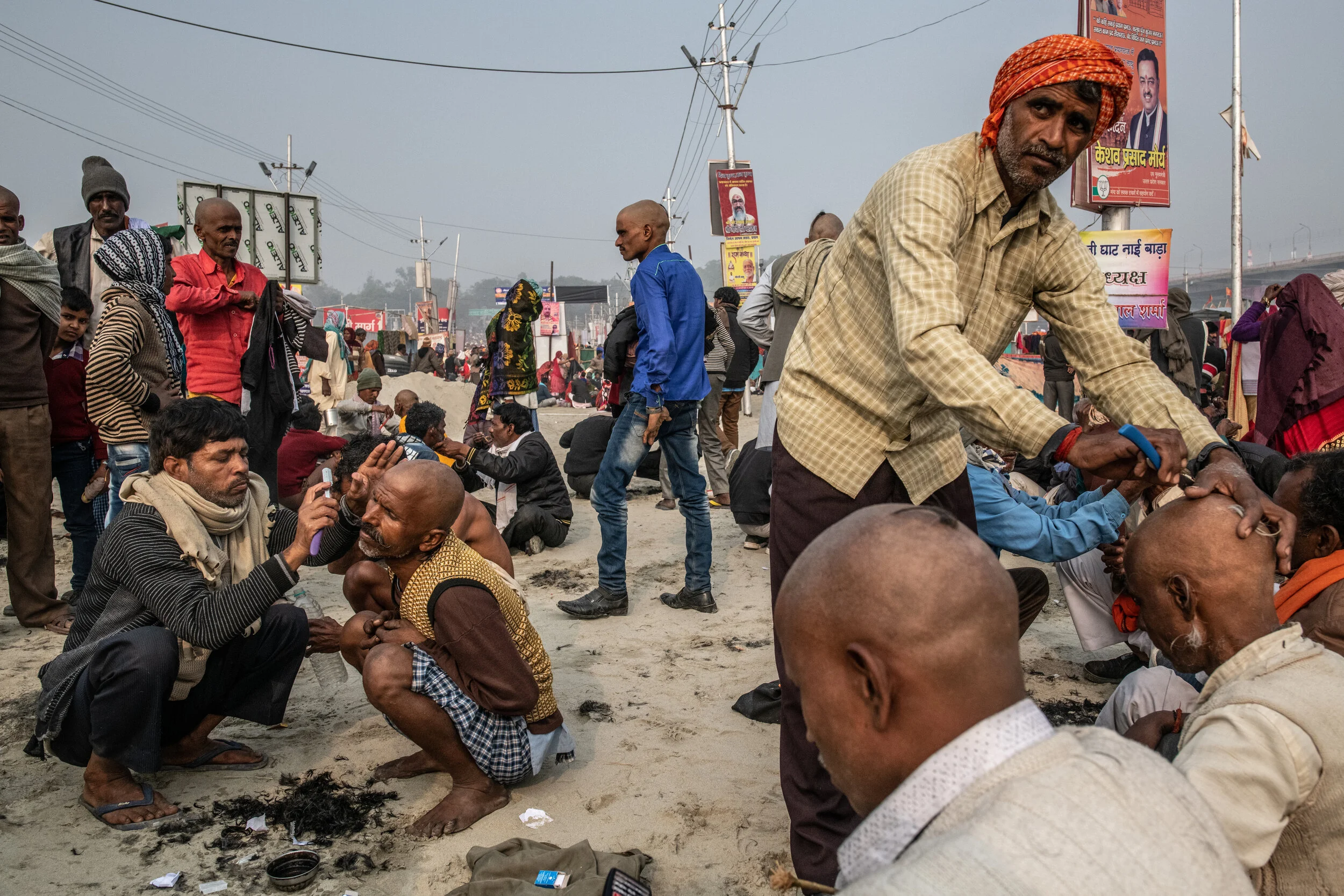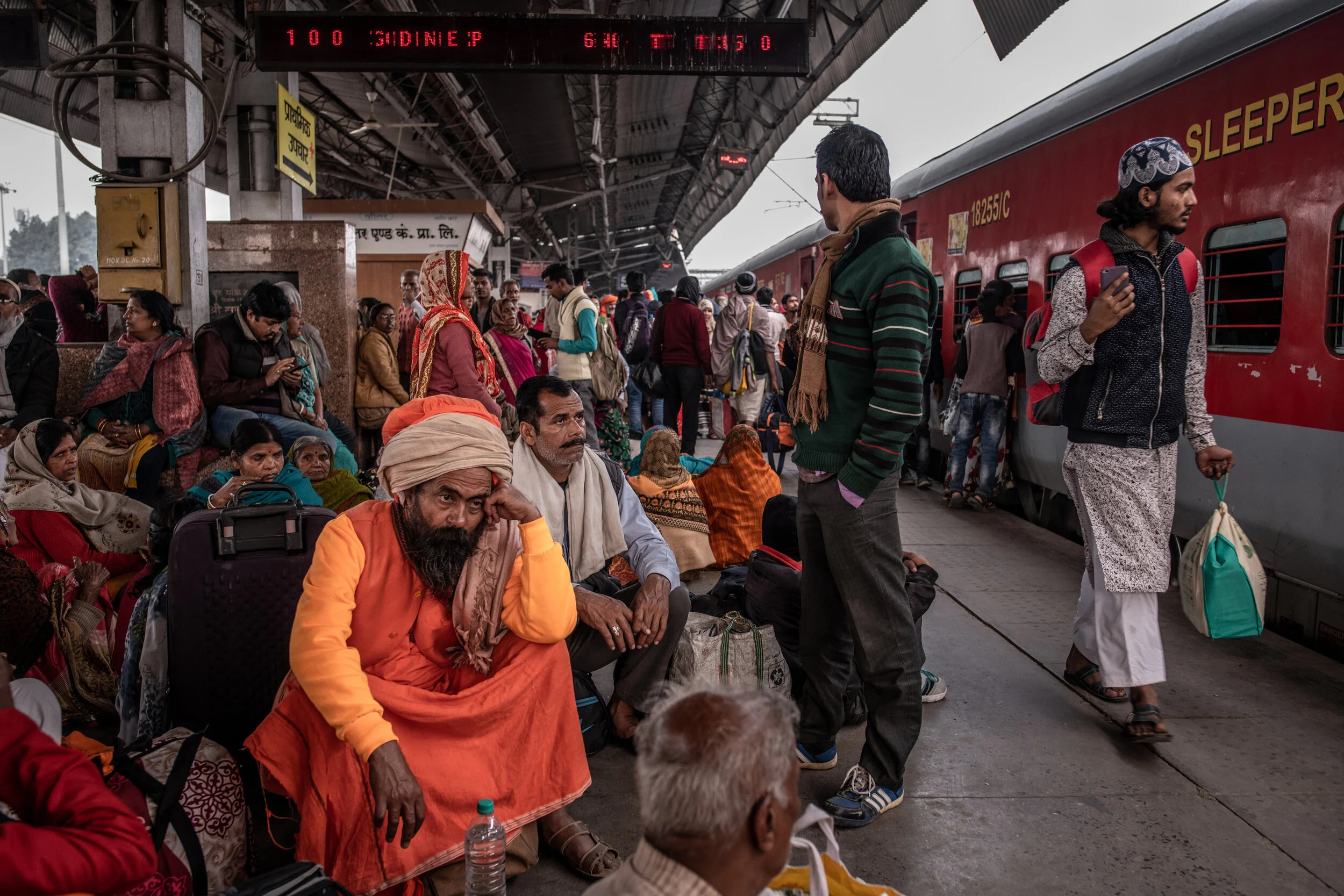
















2/4/2019 Prayagraj, Uttar Pradesh, India
Naga Sadhu's, the Hindu faith's ascetic monks, many naked, armed with swords, tridents and other weapons, draped in garlands of marigolds and covered in ash, plunged into the waters of the Ganges and Yamuna rivers on morning of the Mauni Amavasya, the 2nd and most auspicious of the Shahi Snan bathing ceremonies, on the banks of the Sangam bathing site, during the Ardh Kumbh Mela in Prayagraj, India.
The 2019 Ardh Kumbh Mela, held in the newly renamed city of Prayagraj (formerly Allahabad), is expected to be the largest gathering of people in earth's history, with over 120 million people expected to attend during the Hindu religious festival's run from January 15 through March 4, 2019. The religious rituals of the Mela have remained fairly consistent for hundreds of years, as pilgrims flock to the confluence of the Ganges and Yamuna rivers to bath away their sins. But every Kumbh gives birth to it's own city on the banks of the river, and over time, what began as a spiritual journey dictated by planetary alignment has become a multi-faceted exercise in urban planning, crowd management, entertainment, big business and politics.

2/3/2019 Prayagraj, Uttar Pradesh, India
An Aerial view of the Sangam bathing site, at the confluence of the Ganges and Yamuna rivers, in Prayagraj, India, as seen from a helicopter.

2/7/2019 Prayagraj, Uttar Pradesh, India
A young pilgrim shivered after emerging from the waters of the holy Sangam bathing area at the confluence of the Ganges and Yamuna rivers, in Prayagraj, India, as women made offerings nearby, during the Ardh Kumbh Mela.

2/3/2019 Prayagraj, Uttar Pradesh, India
A Hindu priest performed the morning Ganga Aarti, along the eastern banks of the Ganges river as followers listened nearby, at Prayagraj, India, during this year's Ardh Kumbh Mela.

2/5/2019 Prayagraj, Uttar Pradesh, India
Visiting Japanese Hindu devotees climbed out of a truck as their group visited an Akhara located in the Kumbh Nagari—the makeshift city that springs to life to accommodate all of the religious camps and pilgrims. While foreigners have long had a presence at the Kumbh Mela, this year's Ardh Kumbh Mela was actively marketed as a tourism event to foreigners.

2/5/2019 Prayagraj, Uttar Pradesh, India
Hindu pilgrims moved through the streets and lanes of the Kumbh Nagari, the temporary city constructed on the vast banks of the Ganges river, during this year's Ardh Kumbh Mela, in Prayagraj, India.

2/3/2019 Prayagraj, Uttar Pradesh, India
Pilgrims made prayers in the waters on the eastern banks of the Ganges river during this year's Ardh Kumbh Mela, in Prayagraj, India.

2/4/2019 Prayagraj, Uttar Pradesh, India
Hindu devotees looked on as Gurus and Akhara leaders paraded on lavishly decorated carts and trucks on morning of the Mauni Amavasya, the 2nd and most auspicious of the Shahi Snan bathing ceremonies, toward the banks of the Sangam bathing site, during the Ardh Kumbh Mela in Prayagraj, India.

2/5/2019 Prayagraj, Uttar Pradesh, India
Laxmi Narayan Tripathi, right, the chief of the Kinnar Akhara, received alms and gave out blessings to devotees during a large gathering in a receiving tent at the Kinnar Akhara's camp, in the Kumbh Nagari (city), in Prayagraj, India, during the Ardh Kumbh Mela. For members of the Kinnar (transgender) community, this year's Kumbh Mela has been historic, as it is their first year participating in the religious festival as a fully recognized Akhara, after India's Supreme Court officially recognized the existence of a third gender in 2014. The Kinnar draw their name from the Kinnara, mentioned in Hindu texts, as part man, horse, and bird, known for their proximity to the gods.

2/5/2019 Prayagraj, Uttar Pradesh, India
A transgender member of the Kinnar Akhara peaked her head out of one of the tents at the Akhara's camp, in the Kumbh Nagari (city), in Prayagraj, India, during the Ardh Kumbh Mela. For members of the Kinnar (transgender) community, this year's Kumbh Mela has been historic, as it is their first year participating in the religious festival as a fully recognized Akhara, after India's Supreme Court officially recognized the existence of a third gender in 2014. The Kinnar draw their name from the Kinnara, mentioned in Hindu texts, as part man, horse, and bird, known for their proximity to the gods.

2/3/2019 Prayagraj, Uttar Pradesh, India
Barbers shaved the heads of pilgrims following their baths at the holy Sangam bathing area on the Ganges and Yamuna rivers, in Prayagraj, India. The Shaving of the head except for a small patch at the top, is meant to be a part of the purification process, that sees the sins of the bather wiped away by the holy waters of the river.

2/3/2019 Prayagraj, Uttar Pradesh, India
The eastern banks of the Ganges at Triveni were packed with pilgrims preparing to take their baths during the Ardh Kumbh Mela in Prayagraj, India.

2/4/2019 Prayagraj, Uttar Pradesh, India
Naga Sadhu's, the Hindu faith's ascetic monks, many naked, armed with swords, tridents and other weapons, draped in garlands of marigolds and covered in ash, chanted as they marched to the banks of the Sangam bathing area, in the early morning of the Mauni Amavasya, the 2nd and most auspicious of the Shahi Snan bathing ceremonies at the Ardh Kumbh Mela in Prayagraj, India.

2/5/2019 Prayagraj, Uttar Pradesh, India
Pilgrims shopped at roadside stalls as an elephant collected and passed up alms for his Mahout (elephant driver), as it walked through the streets of the Kumbh Nagari—the temporary city that springs up during the Kumbh Mela. This year's city is the largest ever, occupying nearly 45 square kilometers.

2/7/2019 Prayagraj, Uttar Pradesh, India
Pilgrims waited to cram into train carriages at the Prayagraj Junction station, following their attendance of the Ardh Kumbh Mela, in Praygraj, India.

2/3/2019 Prayagraj, Uttar Pradesh, India
Migratory birds flew over one of the many pontoon bridges, packed with Hindu Pilgrims, in the early morning light. The bridges are constructed temporarily to accommodate the millions of pilgrims that commute from the Kumbh Mela City, build on the sandy banks of the Ganges river, to the Sangam bathing site, which is located on a peninsula that juts out where the Ganges and Yamuna rivers meet, in Prayagraj, India.